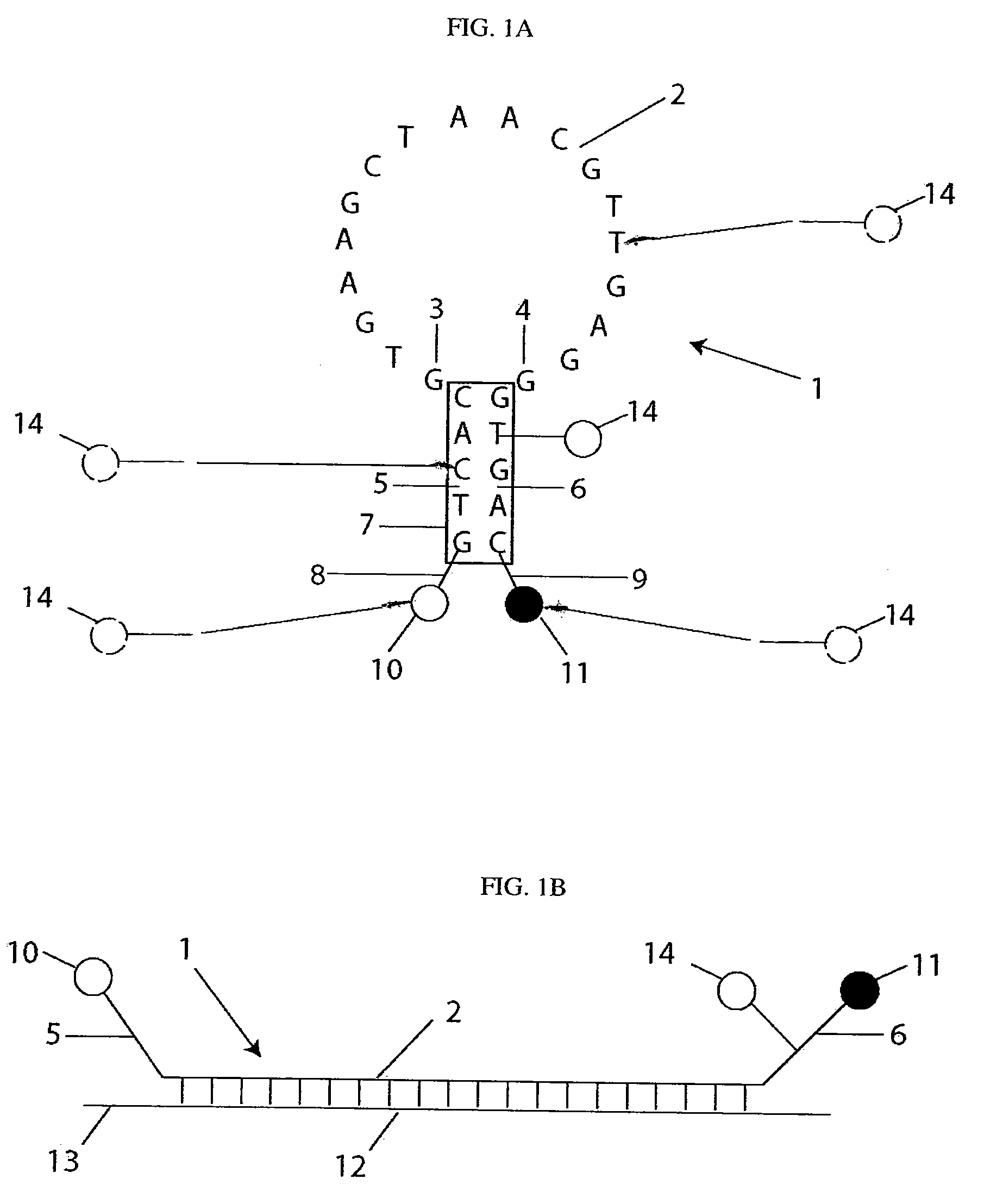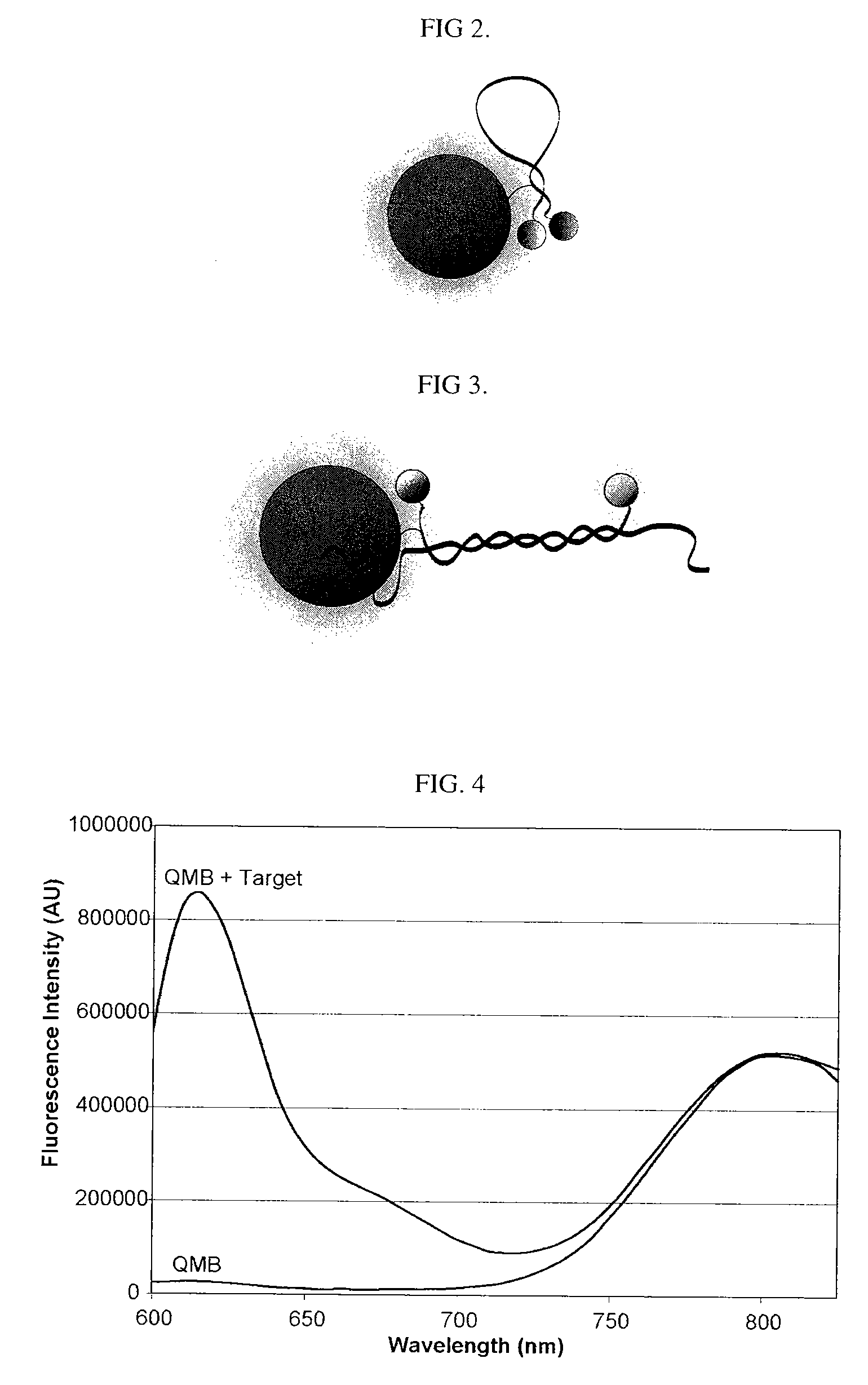Quantitative molecular probes
a molecular probe and quantification technology, applied in the field of molecular probes, can solve the problems of difficult amplification steps, particularly difficult quantification of mirna, and inability to provide complete spatial-temporal profiles of gene expression at the single cell level, so as to improve signal-to-background, improve spatial quantification, and improve quantification
- Summary
- Abstract
- Description
- Claims
- Application Information
AI Technical Summary
Benefits of technology
Problems solved by technology
Method used
Image
Examples
example 1
[0172]Synthesis of quantitative molecular probes: As a precursor to the ‘quantitative molecular probe’ (QMP), an antisense molecular beacon possessing an amino-linker within its stem was synthesized using standard phosphoramidite chemistry (FAM-GTCACCTCAGCGTAAGTGATGTCG / aminoC6T / GAC-Dabcyl) (SEQ ID NO: 15). To cross-link the aminated molecular beacons to quantum dots (Qdot 655, Quantum Dot Corp.), a 10 μM sample of the beacon was reacted with a 50-fold excess of Disuccinimidyl Suberate (DSS, Pierce) in DMSO at 40° C. for 2 hours. The activated molecular beacon was then acetone precipitated, and subsequently reacted with 6 μM Amino (PEG) quantum dots (QDs) at molar ratios of 25:1, 10:1, or 5:1 molecular beacons to QD in 50 mM Sodium Borate, pH 8.2 at 37° C. for 2 hours. QD-molecular beacon conjugates (QD-QMPs) were purified from unbound molecular beacons by gel chromatography (Superdex, Amersham). The number of molecular beacons per QD was quantified spectrophotometrically. The QMPs p...
example 2
[0174]Synthesis of quantitative molecular probes: As an alternative to QD-QMPs, another embodiment consists of neutravidin-based QMPs, where fluorescently-labeled neutravidin serves as the reference dye. Cy5.5-neutravidin was synthesized by first reacting 33 μM neutravidin with Cy5.5 N-hydroxysuccinimide (Amersham) at molar ratios of 3:1, 5:1, 10:1, and 20:1 in PBS, pH 7.4 for 2 hours. The Cy5.5-neutravidin conjugate was purified from free Cy5.5 by gel chromatography (PD-10, Amersham) and the labeling ratio was determined spectrophotometrically. The number of Cy5.5 dyes per neutravidin varied from 0.5 to 2. To attach the aminated-molecular beacons to the Cy5.5-neutravidin conjugate, 33 μM molecular beacons were reacted with a 10-fold excess of NHS-biotin (Pierce) in DMSO at 40° C. for 2 hours. The molecular beacon-biotin conjugate was purified by gel chromatography (NAP-5, Amersham). Alternatively, molecular beacons were synthesized with a biotin label directly incorporated into the...
example 3
[0175]Synthesis of quantitative molecular probes: Antisense Firefly luciferase (pGL3-Luc 235-252, promega) and antisense c-myc (564-581, GenBank Accession V00568) molecular beacons were labeled at the 5′-end with a CAL Fluor® Red 610 (Biosearch Technologies) fluorophore, Cal610, and at the 3′-end with Iowa Black RQ quencher, IAbRQ. In addition, a biotin linker was inserted within the 3′-stem. The luciferase antisense molecular beacon sequence and labeling scheme was / Cal610 / GTC ACC TCA GCG TAA GTG ATG TCG / ibiodT / GA C / 3IabRQ. The c-myc antisense molecular beacon sequence and labeling scheme was / Cal610 / GTC ACG TGA AGC TAA CGT TGA GGG / ibiodT / GA C / 3IabRQ. Luciferase and c-myc target oligonucleotides were synthesized with the sequences, GTC ACG ACA TCA CTT ACG CTG AGT TT and GTC ACC CTC AAC GTT AGC TTC ACT TT, respectively. Antisense c-myc 2′-O-methyl oligonucleotides were synthesized with the sequence GTG AAG CTA ACG TTG AGG (SEQ ID NO: 27).
[0176]Biotinylated molecular beacons were cro...
PUM
| Property | Measurement | Unit |
|---|---|---|
| Force | aaaaa | aaaaa |
| Amphiphilic | aaaaa | aaaaa |
| Length | aaaaa | aaaaa |
Abstract
Description
Claims
Application Information
 Login to View More
Login to View More - R&D
- Intellectual Property
- Life Sciences
- Materials
- Tech Scout
- Unparalleled Data Quality
- Higher Quality Content
- 60% Fewer Hallucinations
Browse by: Latest US Patents, China's latest patents, Technical Efficacy Thesaurus, Application Domain, Technology Topic, Popular Technical Reports.
© 2025 PatSnap. All rights reserved.Legal|Privacy policy|Modern Slavery Act Transparency Statement|Sitemap|About US| Contact US: help@patsnap.com



